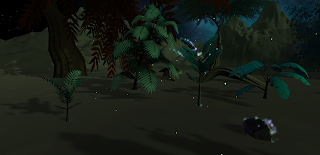As I mentioned in a post at the start of Summer, I attended an event in May called Oculus Launch Pad, which focused on trying to bring more diverse developers into the VR space. The Oculus Launch Pad is offering a scholarship for those of us who participated, and the scholarship winner is chosen based on a pitch and demo. For the Summer of 2016 my main focus is putting together a killer pitch and demo to submit to the program. To that end, I've been working on a little VR prototype that I would like to tell you about.
The idea is a VR hidden object game. Much like a traditional hidden object game, the player is given a list of items to find and then presented with a scene where those items fit in.
The big difference from a traditional hidden object game is that the player is completely immersed in the scene, and looks around in a 3D 360 degree environment, rather than staring at a 2D screen. The other big difference is the method by which items are "found". In a traditional hidden object game the player taps or clicks on the items, and there is often no penalty for mis-clicking on the wrong items.
In this game, every object can be interacted with, and the method of interacting is to stare at the object...until it explodes! This plays off the common fantasy of being able to control/alter your own environment using only your mind.
To score points the player must explode the correct items, but points are lost of the player explodes the wrong items.
I started working on this at the beginning of the Summer, but I fell behind in the month of July - but for a good cause! I spent July running a Game Dev camp for high school kids. The camp, plus my regular part-time teaching job, had me teaching over 60 hours a week! It was insanity, but it was amazing, and seeing the kids' projects when they were done was a very proud moment for me since most of them came to the camp with no development experience at all.
But now I am back and ready to go on full-swing with my VR project. Last week I spent setting up my Unity project, finding and purchasing an Art Asset pack, and playing around with particle systems (this will be a big part of my demo). Screenshot time!
So far I've just being messing with the art and particles for visuals - my next step will be to see how much art the GearVR can handle (mobile devices usually have some pretty hard limits on lighting, shadows, particles, texture resolutions, etc). We'll see how it goes!
Side note: I'm so glad my previous post had the list of steps for getting a build from Unity onto the GearVR, because I have completely forgotten the process! Hooray for forward thinking ~
As always, thanks for reading!
